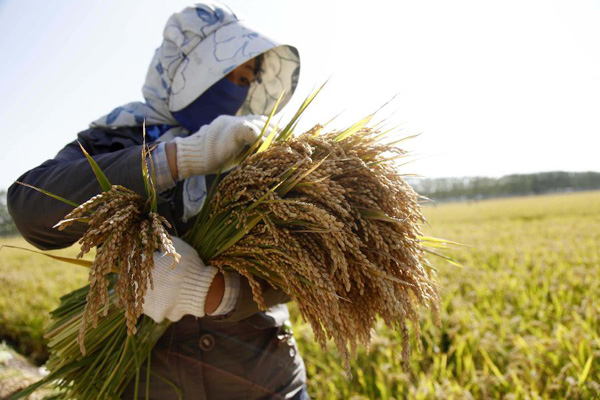

|
 |
|
A farmer harvests rice in Guanyun county in Lianyungang city, east China's Jiangsu province, Oct. 15, 2013. [Photo/Xinhua] |
The China National Grain and Oils Information Center said the per hectare rice production level has also declined, with the rice yield per hectare falling 1.7 percent to 6.7 tons this year. However, the corn and wheat yields per hectare rose 2.6 and 1.6 percent, respectively.
"The fast pace of industrialization and urbanization has transformed a number of rice farmland areas into manufacturing facilities and residential housing projects. This transformation to a certain extent has gradually shifted the country's rice production center from the south to the north," said Wen Tiejun, dean of the school of agricultural economics and rural development at the Beijing-based Renmin University of China.
Wen said that outdated grain logistics services have also hampered the efficiency of the rice production system.
The northeast region is far away from the major rice consumption provinces, but the grain logistics system is not ready for that challenge yet.
For instance, rice transportation costs from Heilongjiang province to major consumer markets in Zhejiang and Jiangsu now account for about 30 percent of retail rice prices, according to a study by the Harbin-based Northeast Agricultural University. That puts extra pressure on logistics companies to satisfy rice demand during peak seasons, and offers opportunities for companies in South China to buy rice from neighboring countries such as Cambodia, Myanmar and Vietnam.
Ding Lixin, a researcher at the Chinese Academy of Agricultural Sciences in Beijing, said that the increasing rice imports stem from the notable price differences between foreign and domestic rice.
He said that rice imports will be kept at a high level if domestic rice prices continue to rise before the Lunar New Year, which will be in late January 2014.
However, domestic prices might be capped by the increase in imports.
"Under such circumstances, sufficient rice supply from the global market and the low import prices from countries such as Thailand, Indonesia and Vietnam have all become important elements subduing the rising pace of Chinese rice prices," he added.
 Aerobatic team prepare for Aviation Convention
Aerobatic team prepare for Aviation Convention
 China Suzhou Electronic Manufacturer Exposition kicks off
China Suzhou Electronic Manufacturer Exposition kicks off
 'Squid beauty' and her profitable BBQ store
'Squid beauty' and her profitable BBQ store
 A day in the life of a car model
A day in the life of a car model
 Vintage cars gather in downtown Beijing
Vintage cars gather in downtown Beijing
 Asia Bike Trade Show kicks off in Nanjing
Asia Bike Trade Show kicks off in Nanjing
 Student makes race car for 4th Formula SAE of China
Student makes race car for 4th Formula SAE of China
 Beijing suburb to hold 2014 APEC meeting
Beijing suburb to hold 2014 APEC meeting